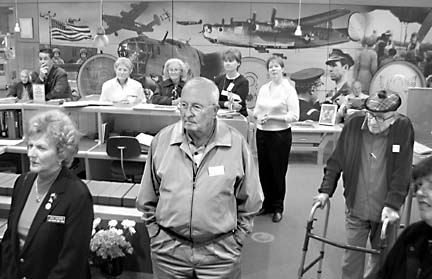

|
My Turn Burl Burlingame |
BURL BURLINGAME / BBURLINGAME@STARBULLETIN.COM
In the great town hall of Norwich, England, veterans of the 8th Air Force inspect the memorial library dedicated to their exploits during World War II. No similar library, archive or repository exists for veterans of Pacific conflicts. Would such a memorial be suitable in a Hawaii location?
Memorials are more
than metal and stoneVeterans are wild about memorials. After all, they've been through the most vivid, heart-wrenching experience of their lives, the folks back home are grateful, they want future generations to remember. So up goes a statue or a marble plinth or a bronze plaque, a monument for the ages -- or, as in the case of the Waikiki Natatorium, a half-century before developers want it torn down.
These monuments are freighted with religious symbolism. It's about as close as the government is allowed to get to promoting religion, even if it's done in a vague, non-ecumenical manner. Christian countries tend to memorialize the concept of sacrifice; Muslim countries canonize victory; Communist countries show off technology and mass-production values.
In America, every town has its Civil War equestrian statue, its Spanish-American War captured cannon, its Great War public structures, its World War II marbles with lists of fallen sons. The mania for public appreciation of military sacrifice began to taper off with the Korean War and Vietnam, and the Gulf War I vets had to settle for showing off captured Iraqi hardware and listening to endless stanzas of "Tie a Yellow Ribbon."
It's not all that easy to put up a monument. It costs money, to begin with. There's also the future dedication of the property itself, as the space around a monument is as critical as the work itself. The most recent major military monument in Hawaii, the Iwo Jima statue that eventually wound up at the gate of Kaneohe Marine Base Hawaii, is the result of a three-year struggle to find a home by the Pacific War Memorial Association (of which I'm a member).
Monies have to be raised not just to build a monument, but to maintain it. The American Battle Monuments Commission won't allow the construction of any memorial overseas unless an endowment or trust fund is also placed into escrow for upkeep. Host countries aren't fond of abandoned memorials.
By their nature, however, memorials are static representations of abstract concepts. They are reminders, little nudges at the consciousness. Memorials are limited in their ability to increase knowledge. They are tombstones for an entire generation, too vast to comprehend. Their silent power often makes visitors uncomfortable instead of curious.
What's the alternative? What sort of memorial is suitable for an information age, a memorial that is dynamic and restless and interactive? A monument that lives?
In the awe-inspiring town hall of Norwich, England, facing a cathedral nearly a thousand years old, the Central Library of East Anglia has a small wing devoted to a memorial library for the Second Air Division, part of the mighty bomber arm of the 8th Air Force in World War II. Created during the war to house American reference books to help the English understand their American cousins, the library has grown to become a centralized reference locus for studying the air war.
It grew that way because of evolution -- it was needed. Outside the reference room of an aviation museum, there's nothing like it for the general public and for scholars.
A memorial library or repository, a site that is vibrant and useful and growing, filled with ideas and knowledge, is an interesting alternate to the concept of cold marble and bronze.
It would be a place where books, photographs, official documents, personal papers, diaries, printed ephemera and artifacts could be stored, preserved and studied. Nowhere in the world is such a repository devoted to the nature of conflict in the Pacific. There are many dealing with European conflicts, and dozens concerning the American Civil War, but the nature of American historiography has always been both Euro-centric and weighted toward the East Coast. To the pols of D.C., the lights of history and culture grow fainter the farther west you go.
Getting one off the ground would be similar to creating a fixed memorial. With a little study, you know what shape and size it's going to be, and what it will cost to launch. A business plan can project how large an endowment is needed to keep it operating in the future.
The tough question is where to put it, a place meaningful, central and accessible. And let's assume Hawaii is the best place for such an archive.
Citizens assume that it's the job of government to run such institutions, since they are so tightly bound up in the educational process. In Europe, public libraries and universities fill that need, but Europeans by nature set greater store by history than Americans do; we treat it as a commodity.
Let us know at the Star-Bulletin if this is an idea worth pursuing, and where such a repository might be placed. In the meantime, more veterans are vanishing every day, and their papers and photographs are vanishing as well.
Burl Burlingame is a Star-Bulletin staff writer. He can be reached at bburlingame@starbulletin.com.
My Turn is a periodic column written by
Star-Bulletin staff members expressing
their personal views.
